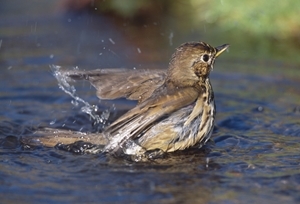Turdus philomelos
 The song thrush is a secretive species, foraging in hedgerows, ditches and undergrowth, so we had to use telemetry to study them during the breeding season.
The song thrush is a secretive species, foraging in hedgerows, ditches and undergrowth, so we had to use telemetry to study them during the breeding season.
Song thrushes nest between March and August and lay a clutch of between two and five eggs, which hatch after 13 days. We found nests by searching suitable areas and then checked them daily. Once the young were at least two days old, we caught the males using mist nets at the nest. We chose males because they do most of the foraging, while the female spends most time brooding the young, thus males give a better indication of habitat use.
We used ‘back-pack’ radio-tags, which weighed less than 5% of the bird’s weight and were fitted with thermistors (tiny thermometers), which told us that birds were alive and well. We took a series of ‘fixes’ over at least three days for each bird and plotted them on a map to determine foraging habitat.
Most song thrushes nested in woodlands and hedgerows and some females settled less than 15 metres apart. Nesting survival was better in these habitats than in gardens, where the largest cause of nest failure was predation during incubation. Nest survival was positively related to predator control. Nest survival during incubation increased with the amount of permanent pasture around the nest. Pastures are rich in earthworms, and this may have allowed females to spend more time on their eggs and less time foraging for food. In woodland, nest survival was low at the beginning and end of a season, perhaps reflecting changes in habitat structure and concealment from predators.
Relative to availability, woodland, hedgerows and field boundaries were the habitats used most by song thrushes when feeding their young and these held most earthworms and other invertebrates. Song thrushes did not use wildlife crops or set-aside when feeding their young.

Download Peter Thompson's essential 26-page book, featuring beautiful photography and detailed profiles of Britain's wildlife
Download FREE >